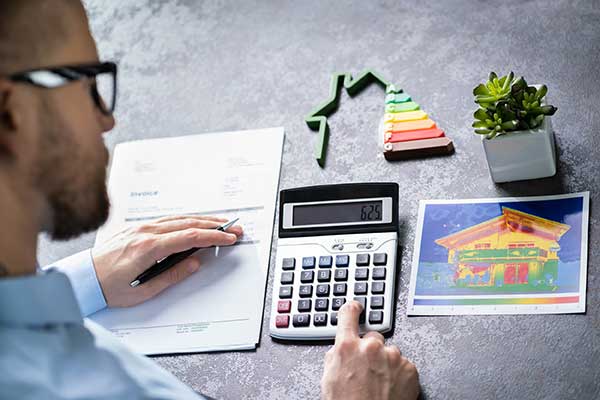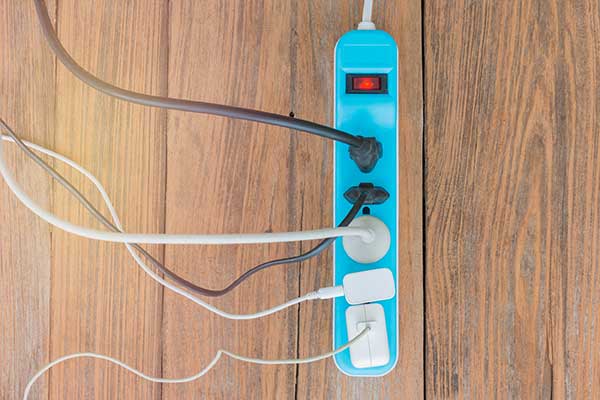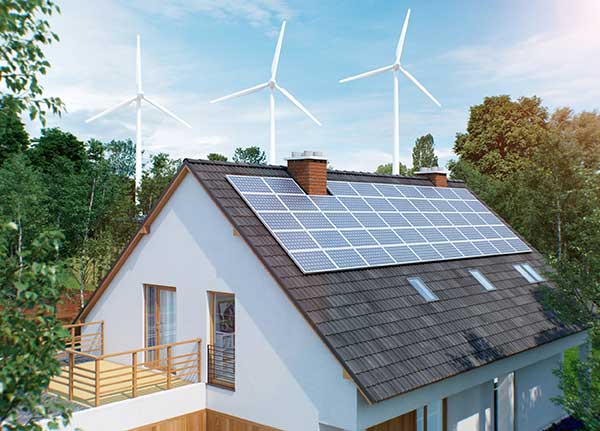In the United States, utilities are a big part of our budget. The average monthly electricity bill costs around $110. Natural gas bills are closer to $72 per month on average, and water usage tacks on an additional $70 per month. Of course, that’s just a nationwide average. For many states, utility bills are much higher.
If you’re looking for ways to save energy at home, you’ve come to the right place. This detailed guide outlines everything you need to know about using less energy and lowering your energy costs. From quick and simple energy-saving tips to finding the most energy-efficient appliances, we’ve got you covered. You’ll soon become an expert on energy conservation, and your reward might be a lower energy bill.
How Do I Improve Energy Efficiency in My Home?
Improving the energy efficiency in your home doesn’t have to be complicated or costly. There are so many ways to lower your energy use that it would be tough to tackle them all. Even so, choosing just a few methods is likely to make a significant impact on your pocketbook and the planet as well. That’s because our most prominent resources for producing energy are fossil fuels such as coal, oil, and natural gas. We produce energy by burning these fossil fuels, but doing so creates carbon dioxide emissions, which is a leading contributor to global warming.
If saving money isn’t reason enough to improve your home’s energy efficiency, perhaps lowering your global impact is the extra incentive you need. The easiest way to get started is to take a walk around your home to perform an energy audit.
What Should I Look for During a Home Energy Audit?
During an energy audit, walk from room to room looking for different areas where you can make improvements that could increase your home’s energy efficiency. Don’t plan to fix anything during the audit. At this point, you’re merely taking notes on what you feel needs to happen. Then you can go back to check off tasks here and there when you have the time.
11 Critical Areas To Target While Performing a Home Energy Audit:
- Fix plumbing issues such as leaky faucets and running toilets.
- Check to see if you have water-efficient or low-flow faucets and shower heads. (If not, consider making the swap).
- Insulate any crawl spaces or attic space that’s missing insulation to stop significant air leaks.
- Feel around all of your windows and doors for air leaks. If you feel cold air or warm air seeping in, add caulk and weather stripping to reduce heat loss and save on your cooling costs.
- Plug unused electric outlets with safety plugs to stop cold air from leaking in.
- Add power strips where possible to make it easier to turn off electronics and other devices when not in use.
- Determine where you can plant shade trees or bushes to limit thermal heat from the sun from entering through your windows.
- When the time comes, replace old appliances with energy-efficient appliances.
- Look for signs of improper ventilation around any appliances that use natural gas or another fuel.
- If you don’t have one already, install a programmable thermostat.
- Determine if you’d like to schedule a professional home energy audit or professional energy assessment.
How Does a Programmable Thermostat Save Energy?
By lowering your thermostat from its typical setting by as little as 7-10 degrees Fahrenheit for eight hours per day, you can save up to 10% each year on your energy bill. Manually changing your thermostat multiple times per day is cumbersome, not to mention uncomfortable since you have to wait while the temperature adjusts to where you like it.
However, with a programmable thermostat, you can easily set these temperature adjustments to occur automatically. That way, your house can be cooler at night when you’re sleeping but back to a comfortable temperature by the time your alarm goes off. Likewise, suppose you are gone at work all day. In that case, you can set your thermostat so that the temperature in your home is lower when no one’s there but toasty warm before you’re scheduled to get back home.
In the winter, it’s recommended that you stick to no warmer than 68°F. At the same time, in the summer, your air conditioning shouldn’t be cooler than 78°F in order to experience the best energy-efficiency rates. The closer you can keep your home’s internal temperature to the temperature outside, the more energy you’ll be saving.
You can simplify temperature regulation even more by installing a smart thermostat. For example, say your schedule changes or you’re out of town but realized that you forgot to turn off the lights. With a smart thermostat, you can adjust your home’s temperature, control your lights, and even check your energy usage pattern without even being home. You can manage your smart thermometer by using an app on your phone or another smart device from wherever you are.
Why Should I Use Energy Efficient Appliances and Electronics?
Energy-efficient appliances and electronics tend to cost a bit more upfront, but you’ll end up making that difference back and more with your lowered energy bill. Plus, not only do energy-efficient appliances cost less to use, but they also help in the fight to reduce greenhouse gas emissions.
How Do I Know if an Appliance or Electronic Device Is Energy-Efficient?
Today, finding energy-efficient appliances and electronics is as easy as looking at the product to see if it has an ENERGY STAR® label on it. ENERGY STAR is a program backed by the U.S. government that works alongside the U.S. Environmental Protection Agency (EPA). They label products that meet their high energy efficiency standards.
What Appliances and Electronics Should I Consider Replacing With ENERGY STAR® Products?
The ENERGY STAR program provides a credible, unbiased, and simple way for consumers to make well-informed appliance and electronic purchases. Washers and dryers, kitchen appliances, HVAC systems, and ceiling fans are some of the most important appliances to consider purchasing. Let’s take a closer look to find out why.
Washing Machines and Clothes Dryers
ENERGY STAR clothes washers and dryers utilize 20% less energy than conventional washers and dryers. ENERGY STAR washing machines also save water for you, using 35% less water than standard models.
Kitchen Appliances Such as Dishwashers, Cooktops, Ovens, and Refrigerators
A new ENERGY STAR labeled refrigerator uses 15% less energy than all other models and 40% less energy than standard 2001 models. When it comes to dishwashers, ENERGY STAR labeled products use 4.25 gallons less water per cycle than conventional models. ENERGY STAR labeled natural gas ovens with automatic, electric ignition systems are the most energy-efficient models currently available.
Heating, Ventilation, and Air Conditioning (HVAC) Systems
The industry’s best heating systems can achieve an energy-efficiency rate as high as 98.5%, which means practically all the fuel used is converted into heat for your house. These systems have the potential to cut your fuel bills and pollution output in half. The result is an average savings of 1.5-2.5 tons of carbon dioxide emissions each year based on the type of fuel used. Plus, making the switch to a high-efficiency air conditioner can help to reduce your air conditioning energy consumption by as much as 50%.
Ceiling Fans
Ceiling fans circulate air around a room more efficiently than other fan styles. When it’s warm out, set your ceiling fan blades to spin counterclockwise. Spinning in this direction will result in the blades pushing air down to create a cool breeze and help with your air conditioner’s efficiency. During cold air months, flip that little switch to make your fan spin clockwise. Keeping it on a low setting will circulate the warm air that naturally rises to the ceiling. This circulation of air can save you up to 15% on your energy bill. An ENERGY STAR® labeled ceiling fan is 20% more efficient than conventional models.
Home Office Equipment
Remote work has become more common and ENERGY STAR-labeled office equipment is just as crucial of an investment as appliances. In general, ENERGY STAR-labeled office products only use around half the amount of energy as standard equipment. However, some products can produce as much as 75% in energy savings.
Enter your ZIP Code and compare electricity rates
Light Bulbs
An extremely straightforward way to lower your electricity bill is by changing out your traditional incandescent light bulbs. And since the average homeowner dedicates around 5% of their energy budget to lighting, this simple switch can really pay off. Swapping out just five frequently used incandescent bulbs for ENERGY STAR labeled compact fluorescent lamp (CFL) bulbs can save you as much as $45 a year. Now imagine what that would add up to if you changed all of the light bulbs in your entire house.
More Energy-Saving Tips: Simple Hacks To Reduce Energy Usage at Home
We’re all spending more time at home these days, resulting in a spike in our home energy usage. Fortunately, there are plenty of easy little ways to cut back on our energy usage that don’t require the use of tools or making expensive new purchases. You can even try out some of these simple hacks right away.
- Turn off all of the lights when you’re leaving a room.
- Unplug chargers that aren’t being used.
- Switch off power strips and other electronics when not in use.
- Set your computer to go straight into sleep mode and avoid using screen savers.
- Turn your hot water heater thermostat to 120-140 degrees Fahrenheit.
- Wrap your water heater in what’s called an insulating blanket to improve its energy efficiency.
- Wash only full loads of laundry using cold water or warm water rather than hot water.
- Remove lint from the dryer prior to each use to maximize efficiency.
- When the weather allows, opt to air-dry clothes instead of using the dryer.
- Use toaster ovens, slow cookers, or microwaves instead of the oven when possible.
- Every time you let warm air into the refrigerator by opening the door, it takes additional energy for the refrigerator to cool back down. Limit how frequently and how long you open the refrigerator door.
- Change the air filters in your HVAC as frequently as the manufacturer recommends. Dirty filters slow down the airflow, making your system work harder.
- Open window coverings on cold days when the sun is shining for some free thermal energy heat, but keep them closed on cold, cloudy days as well as hot weather days.
- Avoid as much energy usage during your provider’s peak hours as possible. Contact your energy provider to ask about when their peak hours are and if they offer any related incentive programs.
What Are Energy Efficient Building Practices?
Suppose you’re looking into doing an extensive house remodel, or you’re planning on building a new home from scratch. In that case, you’ll experience the most savings if you take the time to include all of the energy efficiency options that you’d like to practice in your initial planning process.
Consider the many options listed above, including the appliances you will be using and your energy audit, which should help you understand how and where you use the most energy. Also, take into account your local climate, the conditions of the site around you, your energy plan options, and the possibility of incorporating a renewable energy system.
What Are Some Renewable Energy Sources To Consider When Remodeling or Building a Home?
Renewable energy sources, also referred to as alternative energy sources, are substitutes for using fossil fuels. Generally, they have a low environmental impact. Unlike fossil fuels, such as oil, coal, and natural gas, renewable energy is a natural process that can’t be exhausted since it’s regenerated indefinitely.
Using these greener energy solutions, we can help make a positive impact on the environment by reducing greenhouse gas emissions produced by burning fossil fuels. Some energy providers even offer eco-friendly plans where you can choose to offset your home energy usage by purchasing renewable energy credits. By adding a green component to your plan, the offset amount can be 100% or 50%, so consider these renewable energy options when making plans for your remodel or building project:
Solar Energy Systems
Generating energy through the sun’s power is one of the easiest and most popular renewable energy sources. Solar panels are typically installed directly onto your roof, although occasionally, small panels are placed in your yard. Installing solar panels will trim your energy bill. Homeowners that install solar energy systems may also qualify for additional savings in federal tax credits, rebates, and other incentives.
Cool Roofs
It’s not exactly a renewable energy source since they don’t produce energy, but cool roofs are still a very green option to help with energy conservation. Cool roofs are designed to absorb less heat by reflecting the sunlight more than a standard roof does. They work with most roofing materials and are made of a sheet covering, or highly reflective paint, tiles, or shingles.
Most roofs can reach up to 150°F or even hotter in the summer months, whereas a cool roof will remain at least 50°F cooler in the same conditions. You can save money with a cool roof by enjoying rebates, incentives, energy savings on your air conditioning, the possibility of downsizing your HVAC equipment, and an extended roof lifetime.
Wind Turbines
It may be less popular for residential use than solar energy systems, but wind power has its place. Distributed or small wind power refers to small wind turbines with less than a 100-kilowatt capacity. These individual structures are what we use to supply wind power to houses, farms, and small businesses.
Hydropower
One of the cheapest and greener forms of electricity is generated from hydropower. With the flow of moving water, hydroelectricity is made when water behind a dam travels through an intake, hitting blades in a turbine, which then rotates a generator. This action produces electricity which can then be sent across far distances to power our homes.
What Ways To Save Energy Are You Going To Choose?
Will you be taking a trip to the store to replace all of your appliances or starting small with a few light bulbs? Whatever you choose, big or small, you can’t go wrong. Every step you take towards lowering your energy consumption will positively impact the environment around you and your savings account.
Don’t forget to review all of your utility options before selecting an energy plan that best suits your needs. For more information on comparing energy plans, check out the Energy Savings marketplace, where exploring your energy choices is made easier.
Brought to you by energysavings.com
All images licensed from Adobe Stock.
Featured image:







